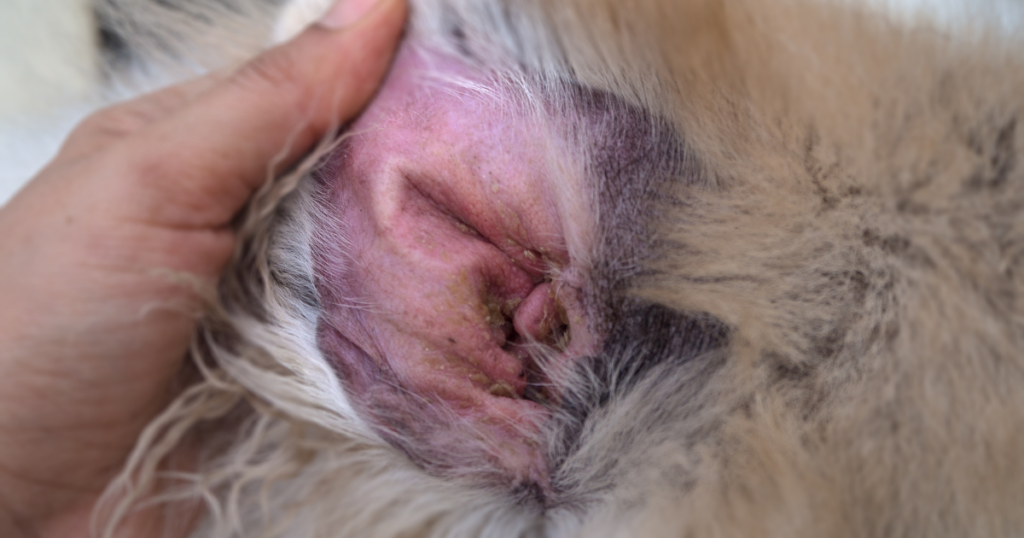Ear mites (Otodectes cynotis) are a common cause of ear infections in dogs, especially in puppies, strays, or dogs living in multi-pet households. These tiny, parasitic mites live in the ear canal and feed on the skin cells of the ear. They cause irritation, inflammation, and intense itching, leading to discomfort for the dog. Ear mites treatment for dogs requires both killing the mites and managing the secondary infections that can result from the irritation.

Table of Contents
Ear Mites Symptoms in Dogs
Ear mites (Otodectes cynotis) are a common external parasite that infest the ear canal of dogs, causing irritation and discomfort. They are highly contagious and can affect both puppies and adult dogs, particularly those in multi-pet households or shelters. The symptoms of ear mite infestations can vary depending on the severity of the infestation, but common signs include:
1. Excessive Scratching or Rubbing of the Ears
- What to Look For: Dogs with ear mites will often scratch or rub their ears on furniture, the floor, or with their paws in an attempt to relieve the itching. Also check Common Skin Diseases in Dogs for reference.
- Why It Happens: The mites cause intense itching by irritating the skin inside the ear canal.
2. Head Shaking or Tilting
- What to Look For: Dogs with ear mites may frequently shake their heads or tilt their heads to one side, trying to alleviate the discomfort.
- Why It Happens: The mites cause irritation and discomfort inside the ear, prompting the dog to shake its head in an effort to relieve the sensation.
3. Dark, Crusty, or Waxy Discharge from the Ears
- What to Look For: A dark, coffee-ground-like discharge is one of the most characteristic symptoms of ear mites. This discharge can range from brown to black and may appear crusty or waxy. In severe cases, the discharge may have an unpleasant odor. Always check your Dog Age Calculator: Pet’s Friend which gives a reference for Dog’s age in Human Years.
- Why It Happens: The mites feed on the skin debris inside the ear canal, and the discharge is a combination of mite debris, earwax, and inflammatory cells.
4. Redness or Inflammation in the Ear Canal
- What to Look For: The ear canal may appear red, swollen, or inflamed due to the irritation caused by the ear mites. Finding this symptom is important for Ear Mites Treatment for Dogs.
- Why It Happens: The constant scratching and irritation caused by the mites lead to inflammation of the ear tissues. This can sometimes lead to more severe complications if left untreated.
5. Foul Odor from the Ears

- What to Look For: A foul, musty, or yeasty smell may be present in the affected ear.
- Why It Happens: The scratching and discharge associated with ear mite infestations can lead to secondary bacterial or yeast infections in the ear, contributing to the bad odor.
6. Ear Canal Swelling or Redness
- What to Look For: Swelling, redness, or tenderness around the outer ear or in the ear canal.
- Why It Happens: The ear mites irritate the sensitive skin of the ear canal, leading to inflammation and swelling.
7. Loss of Hair Around the Ears
- What to Look For: The skin around the ears, especially the area near the base of the ear, may show signs of hair loss due to constant scratching or rubbing. Check the Top 20 Popular Dog Breeds in USA to know which breed is less prone to ear mite infection in dogs.
- Why It Happens: Constant scratching can damage the hair follicles, leading to alopecia (hair loss) around the ears.
8. Secondary Infections
- What to Look For: In some cases, the dog may develop secondary bacterial or yeast infections as a result of the mites. Signs of these infections include:
- Pus-like discharge
- More intense odor
- Excessive pain or sensitivity when touching the ears
- Why It Happens: The irritation and scratching from the ear mites can break the skin and allow bacteria or fungi to enter, leading to an infection.
9. Restlessness or Behavioral Changes
- What to Look For: A dog with ear mites may become more restless, irritable, or exhibit changes in behavior due to the discomfort caused by the infestation.
- Why It Happens: The constant irritation from the mites leads to discomfort and frustration, which can manifest as changes in behavior, such as agitation or lack of sleep.
Other Considerations
- Breed Predisposition: While any dog can get ear mites, those with floppy ears (such as Cocker Spaniels, Basset Hounds, and Beagles) may be more prone to ear problems, as their ear anatomy can create a warm, moist environment that encourages the growth of mites and other ear infections.
- Environmental Factors: Ear mites are highly contagious and can spread between dogs in multi-pet households or places like shelters, kennels, and dog parks. Outdoor dogs that interact with stray or wild animals are also at higher risk.
When to See a Veterinarian
If your dog shows any of these symptoms, it’s important to take them to a veterinarian for a proper diagnosis. While ear mites are a common cause of ear issues, other conditions like bacterial infections, yeast infections, allergies, or foreign bodies can cause similar symptoms. A vet will typically use a microscope to examine an ear swab to confirm the presence of ear mites. Finding Symptoms is important for Ear Mites Treatment for Dogs.
Prompt treatment is essential to prevent the infection from worsening and to relieve your dog’s discomfort. Your veterinarian can recommend appropriate ear mite treatment, such as topical ear drops, oral medications, or cleaning solutions.
If left untreated, ear mite infestations can lead to chronic ear problems, secondary infections, and permanent damage to the ear canal or eardrum.
Summary of Symptoms of Ear Mites in Dogs
- Excessive scratching or rubbing of the ears
- Head shaking or tilting
- Dark, crusty, or waxy ear discharge
- Redness or inflammation in the ear canal
- Foul odor from the ears
- Ear canal swelling or redness
- Hair loss around the ears
- Secondary infections (bacterial or fungal)
- Restlessness or behavioral changes
Note: If you suspect your dog has ear mites, a visit to the veterinarian for proper diagnosis and Ear Mites treatment for dogs to prevent complications and to relieve your dog’s discomfort.
Ear mites Treatment for Dogs Options
1. Topical Treatments (Ear Drops/Solutions)
The most common and effective treatment for ear mites is topical medications. These products are applied directly into the ear canal to kill the mites and reduce inflammation. Some commonly used treatments include:
a. Pyrethrin-Based Products:
- Example: Zymox Otic (with hydrocortisone) or Tresaderm (contains thiabendazole, dexamethasone, and neomycin). It is a good medicine for Ear Mites Treatment for Dogs.
- How it works: These solutions contain insecticides that are toxic to the ear mites and may also help reduce inflammation in the ear.
- Application: Typically, a few drops are placed in the ear canal, and the ear is gently massaged to ensure distribution. Treatment may last 7–10 days or longer, depending on the severity of the infestation.
b. Ivermectin-Based Ear Drops:
- Example: Milbemycin oxime or ivermectin formulations.
- How it works: Ivermectin is a powerful antiparasitic drug that kills ear mites. It’s often used in combination with other medications to prevent secondary bacterial infections.
- Application: Follow the prescribed dosage instructions. Over-the-counter ivermectin solutions are available, but a vet prescription is typically required for oral formulations.
c. Selamectin (Revolution):
- How it works: Selamectin is a topical parasiticide used primarily for flea control but also effective against ear mites. It is important step in Ear Mites Treatment for Dogs.
- Application: Revolution is applied monthly to the skin, typically on the back of the neck. It kills ear mites and other external parasites, such as fleas, ticks, and heartworm.
2. Oral Medications (Systemic Treatment)
In severe cases, or if topical treatments are ineffective, oral medications may be prescribed. These medications are absorbed into the bloodstream and act systemically to kill the mites.
a. Ivermectin (oral):
- How it works: Ivermectin is an antiparasitic drug often used to treat ear mites and other parasitic infections like mange. It can be administered orally and works by disrupting the nervous system of the mites.
- Application: A veterinarian must determine the correct dosage. Ivermectin is highly effective but should be used cautiously in certain breeds, such as Collies or other herding breeds, due to potential toxicity.
b. Milbemycin oxime (Interceptor):
- How it works: Milbemycin oxime is another oral medication that can treat ear mites. It’s generally used when other treatments are not effective.
- Application: This is an oral tablet, and your vet will guide you on the appropriate dose based on your dog’s weight.
3. Cleaning the Ears
Before applying any medication, it’s important to clean the dog’s ears to remove wax, debris, and dead mites, which can interfere with treatment. Use an ear cleaning solution that is gentle and specifically formulated for dogs. It is highly recommended in Ear Mites Treatment for Dogs.
- Recommended Products:
- Virbac Epi-Otic or EarClean.
- How it works: These solutions help loosen wax, debris, and mites from the ear canal and reduce inflammation.
- How to apply: Use a few drops of the cleaning solution, massage the base of the ear gently, and then wipe the ear canal with a cotton ball or gauze. Avoid using cotton swabs, as they can push debris further into the ear canal.
4. Treatment for Secondary Infections
Ear mites can lead to secondary bacterial or yeast infections due to the scratching and inflammation caused by the mites. If your dog has a secondary infection, the vet may recommend additional treatments, including:
- Antibiotics: Topical or oral antibiotics, such as neomycin or amoxicillin, to treat bacterial infections in the ear.
- Antifungal Treatments: If a yeast infection is present, antifungal ear medications like miconazole or clotrimazole may be prescribed.
- Corticosteroids: To reduce inflammation and itching, your veterinarian may recommend a topical or oral corticosteroid.
5. Follow-Up and Prevention
- Follow-Up Visits: After the initial treatment, it’s important to schedule a follow-up visit with your veterinarian to ensure that the ear mites have been eradicated. Your vet may check the ears for residual mites and suggest additional treatments if needed. It is crucial for Ear Mites Treatment for Dogs.
- Prevention: To prevent future ear mite infestations:
- Regularly check your dog’s ears, especially if it spends time around other animals that could carry mites.
- Use a monthly topical treatment like Revolution or Advantage Multi, which not only treats ear mites but also protects against other external parasites like fleas and ticks.
6. Home Remedies (Limited Effectiveness)
While it’s always best to consult with a veterinarian for proper diagnosis and treatment, some dog owners try home remedies like mineral oil, olive oil, or coconut oil to help soothe the ear canal. These oils may help with irritation, but they won’t necessarily kill ear mites. They are more useful for soothing and lubricating the ear canal.
Conclusion
The treatment of ear mites in dogs typically involves topical treatments (ear drops), oral medications, and ear cleaning. Depending on the severity of the infestation and the presence of secondary infections, your vet may prescribe additional therapies. It’s important to follow the full course of treatment to ensure the ear mites are fully eradicated and to prevent re-infestation.
If you’re unsure about the best treatment plan or your dog is showing severe symptoms like intense scratching, head shaking, or discharge from the ears, it’s important to consult with your veterinarian for an accurate diagnosis and personalized treatment recommendations.
Do Check